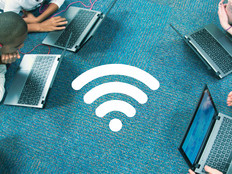Wi-Fi 6 offers faster speeds and better connectivity at 9.6 gigabits per second, up from Wi-Fi 5’s more limited speed of 3.5Gbps. Wi-Fi 6 is also more efficient than its predecessors, but it’s likely the increased speed that will appeal most to users, both in and out of the classroom.
What Are the Benefits of Wi-Fi 6 in K–12 Schools?
When students and teachers returned to in-person learning accustomed to using more devices throughout the school day than ever before, IT leaders quickly noticed their districts would need new Wi-Fi capabilities to keep up.
“Whether it be cellphones, tablets, interactive panels, Chromebooks — it seems like everybody has a Chromebook nowadays — projectors, TVs or asset tagging, with more devices in the classroom, there’s a need for a solution that can handle that load,” says Joseph McGonigle, business manager at NETGEAR.
For a teacher working to capture students’ attention, Wi-Fi speed can make or break an educational moment; for instance, if a video doesn’t load quickly enough, students will lose focus, turning to chat with each other instead. This takes time away from the lesson, as educators work to recapture attention and resume learning.
The pandemic accelerated the push for better Wi-Fi in district buildings, McGonigle says. “Schools didn’t have the Chromebooks and laptops inside of the classroom pre-pandemic, but they were forced to move toward that. There’s definitely a need for increased capacity from an access point on the network.”
DIVE DEEPER: How can school IT teams effectively manage Chromebooks?
He adds that Wi-Fi 6 has a greater channel width, more efficient bandwidth sharing, backward compatibility, and Wi-Fi sleeping for enabled devices. “If the device is still connected to the Wi-Fi but the Wi-Fi isn’t being used, it will take away the bandwidth needed and distribute it to other devices.”
How Can Wi-Fi 6 Accommodate Outdoor Learning?
A few years ago, classes might have gone outside for independent reading time or to learn about nature through a science walk. Now, in addition to those reasons, many educators are leading outdoor classes for the mental health benefits that being outside provides, for better air circulation to reduce virus transmission, or because their lessons integrate outdoor components. But when the teachers and students head outside, so do the devices.
IT teams are left with a tall task: to ensure connectivity for students and teachers whether devices are a few feet outside the building or hundreds of yards away from the school.
“The biggest challenge would be coverage. The way you fix that is with outdoor access points that can be embedded inside the system,” McGonigle says, adding that using mobile routers that operate off of 5G is also an option. “An ad hoc fix would be mobile routers or outdoor access points.”










